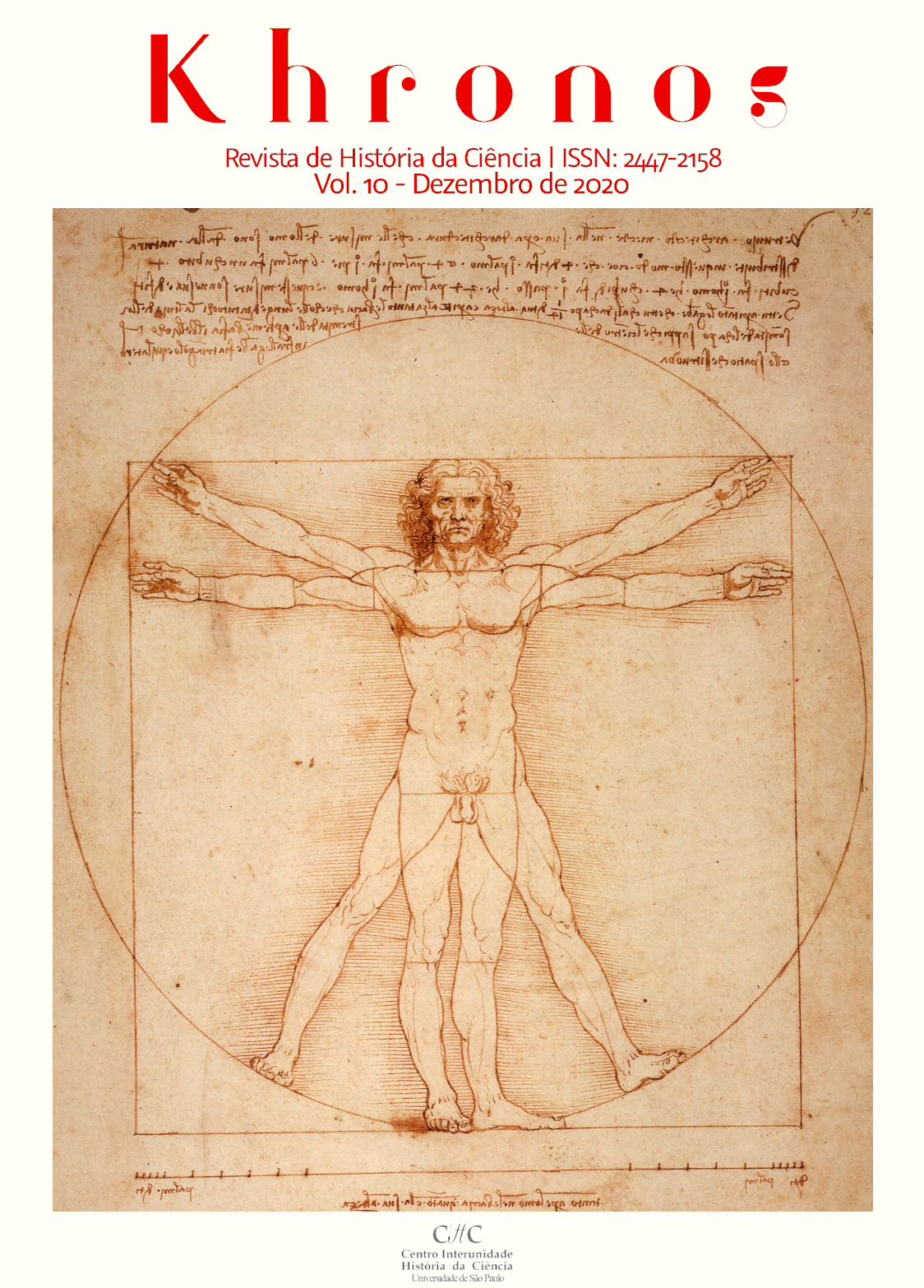Calendários com exibição de Olimpíadas e previsão de eclipses no mecanismo de Antikythera
DOI:
https://doi.org/10.11606/issn.2447-2158.i10p254-322Palavras-chave:
Calendários, Olimpíadas, Eclipses, Mecanismo de AnticíteraResumo
Este artigo apresenta as investigações pioneiras realizadas pelos pesquisadores membros (Freeth et. al., 2008) do Projeto de Pesquisa Mecanismo de Anticitera e demonstram, a partir de análises científicas e tecnológicas dos 82 fragmentos de bronze, suas inscrições e engrenagens, a estrutura e as funções do primeiro computador analógico da história, o Mecanismo de Anticitera, datado entre os séculos150 a.C. -100 a.C., por estes autores.
O aparato, neste contexto, representa a existência da concepção mecânica e da alta tecnologia certamente envolvida neste dispositivo, capaz de prever dados astronômicos tanto do passado, como do presente e do futuro.
Para melhor expor suas investigações referentes aos calendários com exibição das Olimpíadas e de previsão de eclipses localizados na parte posterior do mecanismo, os autores apresentam os dados analisados dos mostradores; Metônico (parte superior) e seus relógios subsídiários das Olimpíadas e do ciclo Calíptico, e, o Saros (parte inferior) com a exposição detalhada, dos fragmentos que compõem cada um dos mostrador, a estrutura desses calendários, com interpretações e combinações de glifos, observações dos esquemas babilônicos para previsões de eclipses lunares e solares, seguido da identificação dos problemas com os glifos das horas destas predições.
Diante deste contexto é oportuno salientar que, alguns pesquisadores do Centro de História da Ciência da Unversidade de São Paulo instauraram no Brasil (2017) um Projeto de Investigação do Mecanismo de Anticitera e tem como parceiros o Museu Cultural Catavento de São Paulo, que expõe no espaço Universo, uma réplica do dispositivo — doada pelos líderes do projeto —, o Centro de Tecnologia da Informação Renato Archer (CTI), e o Núcleo de Tecnologias Tridimensionais (NT3D), de Campinas São Paulo, que reúnem esforços para reconstruir uma réplica dinâmica do aparato com todas as suas possíveis funções descobertas até o momento afim de viabilizar o acesso à história como patrimônio de toda a humanidade e potencializar a educação tecnológica e museal no cenário histórico, cultural e científico.
Downloads
Referências
American Philosophical Society 81/6 (American Philosophical Society, Philadelphia, 1991).
AABOE, A. Remarks on the theoretical treatment of eclipses in antiquity. J. Hist. Astron. 3, 105–118. 1972.
BICKERMAN, E. Chronology of the Ancient World. Thames & Hudson, London, 1968.
BRITTON, J. P. Calendars, Intercalations and Year-Lengths in Mesopotamian Astronomy. In Calendars and Years: Astronomy and Time in the Ancient Near East (ed. Steele, J.M.) 115-132. Oxbow, Oxford, 2007.
BRITTON, J. P. in Die Rolle der Astronomie in den Kulturen Mesopotamiens (ed. Galter, H. D.) 61–76 (rm-Druck & Vergansgesellschaft, Graz), 1993.
CABANES, P. (ed.) Corpus des inscriptions grecques d'Illyrie méridionale et d'Épire. Études epigraphiques 2.2, 98-99 (Fondation D. et É. Botzaris, Athens, 1997).
CABANES, P. Les concours des Naia de Dodone. Nikephoros - Zeitschrift Fur Sport und Kultur Im Altertum 1, 49–84. 1988.
DILLON, M. Pilgrims and Pilgrimage in Ancient Greece. 99–106. Routledge, London, 1997.
ECONOMOU, N.A. in Antikythera Mechanism. Astronomical Measurement Instruments from Ancient Greek Tradition (eds Economou, N. A., Nikolantonakis, K. & Nitsiou, P.) 14 (Technology Museum of Thessaloniki, Thessaloniki, 2000).
EDMUNDS, M. et al. The Antikythera Mechanism research project. Disponível em: <http://www.antikythera-mechanism.com>, 2008.
ESPENAK, F. NASA eclipse. Disponível em: <http://eclipse.gsfc.nasa.gov/eclipse.htmlæ>, 2008.
EVANS, J. & BERGGREN, J. L. Geminos’s Introduction to the Phenomena. Princeton Univ. Press, Princeton, 2006.
FOTHERINGHAM, J. K. The Metonic and Callippic Cycles. Monthly Notices of the Royal Astronomical Society. 84, 383-392, 1924.
FREETH, T. et al. Decoding the ancient Greek astronomical calculator known as the Antikythera Mechanism. Nature 444, 587–591 (2006).
GINZEL, F. K. Handbuch der mathematischen und technischen Chronologie. Hinrichs, Leipzig, 1906-1914.
HADLAND, R. et al. Antikythera mechanism research project: The inspection. Disponível em: < http://www.xtekxray.com/applications/antikythera.htmlæ>, 2008.
HANNAH, R. Greek & Roman Calendars: Constructions of Time in the Classical World. Duckworth, London, 170 p. 2005.
HULTSCH, F. Pappi Alexandrini collectionis quae supersunt 1026 (Book 8, Vol. 3, Weidmann, Berlin, 1878.
HUNGER, H. Astronomical Diaries and Related Texts from Babylonia. Volume V: Lunar and Planetary Texts (Österreichische Akademie der Wissenschaften, Vienna, 2001).
JONES, A. Calendrica, I: New Callippic dates. Z. Papyrologie Epigraphik 129, 141–158, 2000.
KEYES, C. W. Cicero XVI, De Re Publica, Book 1, Sect. xiv, Para. 22. Loeb Classical Library No. 213, Harvard Univ. Press, Cambridge, Massachusetts, 1928.
MALZBENDER, T. & GELB, D. Polynomial Texture Mapping (PTM). Disponível em: <http:// www.hpl.hp.com/research/ptmæ>. 2006.
MORETTI, L. Iscrizioni Agonistiche Greche, (Angelo Signorelli, Rome, 1953).
NEUGEBAUER, O. A History of Ancient Mathematical Astronomy. Springer, New York, 617 p. 1975.
NEUGEBAUER, O. et al. A Demotic Lunar Eclipse Text of the First Century BC. Proceedings of the American Philosophical Society 125, 312-327 (1981).
PRICE, D. de S. Gears from the Greeks: The Antikythera Mechanism—A calendarcomputer from ca. 80 BC. Trans. Am. Phil. Soc. New Ser., 64, 1–70 (1974); reprintedby Science History Publications, New York, 1975).
SAMUEL, A. E. Greek and Roman Chronology, Calendars and Years in Classical Antiquity (Handbuch der Altertumswissenschaft, Abt. 1., Teil. 7, Beck, München, 1972.
STEELE, J. M. Eclipse prediction in Mesopotamia. Arch. Hist. Exact Sci. 54, 421–454, (2000).
STEELE, J. M. Observations and Predictions of Eclipse Times by Early Astronomers. Kluwer, Dordrecht, 2000.
STEELE, J. M. The Length of the Month in Mesopotamian Calendars of the First Millennium BC. In Calendars and Years: Astronomy and Time in the Ancient Near East (ed. Steele, J. M.), 133-148, Oxbow, Oxford, 2007.
TOOMER, G. J. Ptolemy’s Almagest. Duckworth, London, 1984.
TRÜMPY, C. Untersuchungen zu den altgriechischen Monatsnamen und Monatsfolgen (Bibliothek der Klassischen Altertumswissenschaften, NF, 2nd series, Vol. 98, Carl Winter, Heidelberg, 1997.
WALKER, C. B. F. Achaemenid Chronology and the Babylonian Sources. In Mesopotamia and Iran in the Persian Period (ed. Curtis, J.) 17-25, (British Museum, London, 1997)
WRIGHT, M. T. A. Planetarium Display for the Antikythera Mechanism. Horological Journal. 144,169-173, 2002.
WRIGHT, M. T. Counting months and years: The upper back dial of the Antikythera Mechanism. Bull. Sci. Instrum. Soc. 87, 8–13, 2005.
WRIGHT, M. T. Epicyclic gearing and the Antikythera Mechanism, Part I. Antiquar. Horol. 27, 270–279 (2003).
WRIGHT, M. T. Epicyclic gearing and the Antikythera Mechanism, Part II. Antiquar. Horol. 29, 51–63 (2005).
WRIGHT, M. T. The Antikythera Mechanism and the early history of the moonphase display. Antiquary. Horol. 29, 319–329. 2006.
WRIGHT, M. T. The Antikythera Mechanism: A new gearing scheme. Bull. Sci. Instrum. Soc. 85, 2–7 (2005).
Downloads
Publicado
Edição
Seção
Licença
Copyright (c) 2020 Beatriz Bandeira

Este trabalho está licenciado sob uma licença Creative Commons Attribution-NonCommercial 4.0 International License.
Autores que publicam nesta revista concordam com os seguintes termos:
- Autores mantém os direitos autorais e concedem à revista o direito de primeira publicação, com o trabalho simultaneamente licenciado sob a Licença Creative Commons Attribution na modalidade "Atribuição-NãoComercial 4.0 Internacional" (CC BY-NC 4.0) que permite o compartilhamento do trabalho com reconhecimento da autoria e publicação inicial nesta revista.
- Autores têm autorização para assumir contratos adicionais separadamente, para distribuição não-exclusiva da versão do trabalho publicada nesta revista (ex.: publicar em repositório institucional ou como capítulo de livro), com reconhecimento de autoria e publicação inicial nesta revista.
- Autores têm permissão e são estimulados a publicar e distribuir seu trabalho online (ex.: em repositórios institucionais ou na sua página pessoal) a qualquer ponto antes ou durante o processo editorial, já que isso pode gerar alterações produtivas, bem como aumentar o impacto e a citação do trabalho publicado (Veja O Efeito do Acesso Livre).
- Qualquer dúvida ou reclamação sobre direitos autorais devem ser direcionadas ao Conselho Editorial o qual apreciará e se manifestará conforme as diretrizes do Committee on Publications Ethics (COPE).






